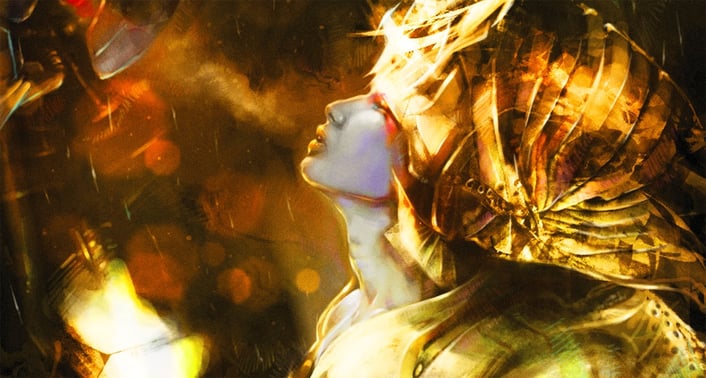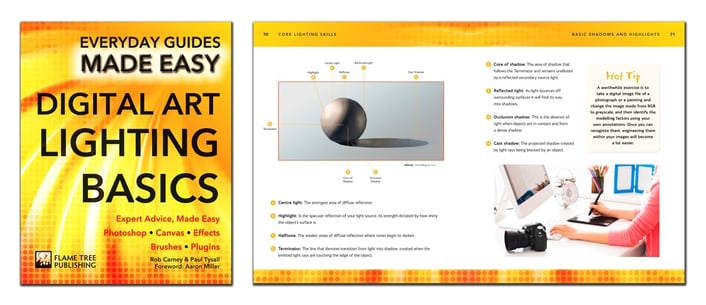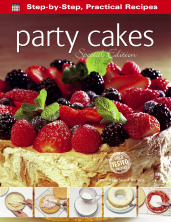 Digital art is becoming more and more popular. Fantastical worlds and realistic images are now being created through photoshop and other digital programs. As with any form of art, it is important to get the lighting just right. To do this, you must get a solid background on lighting and the physics behind it. Today we will look at different types of lighting made easy to help you perfect your art!
Digital art is becoming more and more popular. Fantastical worlds and realistic images are now being created through photoshop and other digital programs. As with any form of art, it is important to get the lighting just right. To do this, you must get a solid background on lighting and the physics behind it. Today we will look at different types of lighting made easy to help you perfect your art!
Frontal Lighting
Frontal lighting is when an artist depicts a light source that is positioned behind the viewer, leaving very little shadow. One characteristic of this approach to lighting a subject is that it leaves a subtle shadow at the form’s edges. This can be depicted as an outline that varies in weight.
Three-Quarter Lighting
Probably one of the most used ways to light a subject, especially in portraiture, this gives the artist more modelling factors to work with whilst also being flattering to the subject. This approach helps to illuminate features of the subject, but also allows for form-describing shadows. In three-quatrter lighting, the light source is commonly low enough to light both eyes, which aids viewer engagement.
Rembrandt lighting is when the light source illuminates the foreshortened side, which creates a shadow from the nose that falls over the shaded side of the face.
Edge (Rim) Lighting
A great way to separate your subject from its background, edge lighting occurs when the light source is located behind the subject, and is typically quite strong. On hard surfaces, it can lead to quite a graphical breakdown of features; on other surfaces, you get subsurface scattering as the light leaves the edge.

Contre Jour
A form of back lighting, which you can think of as the opposite of frontal lighting, this technique can help enhance the silhouette of your subject, making the subject easier to read at a distance. As the source rays of light push past the subject towards the viewer, a soft, ethereal bleeding of light softens the edge of the subject. This is an effective technique used in editorial illustration, as the near-white background can marry well with the white of the page, creating a vignette.
Below Light
Being an uncommon lighting type in the natural world, this technique is loaded with impact. Shadows on a face occur in unusual places and can create a sinister look. Considering the source is often man-made, it is important to remember the interplay of reflected colour on the subject.
Spotlight
This is usually a single light source that is used to target the subject or to draw the viewer’s focus to a specific point within a composition. If you introduce a secondary spotlight on a subject the shadows can double up and overlap. If these strong spotlights are coloured, the hues will be represented at the edges of their corresponding shadows.

Bounced Light
As light rays hit an object and bounce back off – with some hues being absorbed and others reflected – it is easy to understand how a hard, reflective surface can also become another coloured light source. Applying this observation to your art can elevate your images and create original, unexpected effects.
A solid understanding of how light works will help you appreciate what is happening when we look at bounced (or reflected) light. Once you understand what is occurring when light is bounced, you can start to predict how light will behave in other situations.When we observe bounced light, it falls into two basic camps – specular and diffused.
Specular reflection: As light rays hit a hard, smooth surface at one angle, the light is consistently reflected off along the opposing angle. The angle at which light is reflected is dependent on the angle of the surface it is being bounced off. You need to imagine this bouncing of light happening on a microscopic level. This helps to understand diffused reflection.
Diffused reflection: A rough surface can also reflect light, but there are more (microscopic) angles, which send the reflected light in various directions. The results of diffused light are more subtle.
Bouncing Colour
Remember to look for opportunities to bounce colour into your shadows and on to other adjacent surfaces, as this will help tie together colours found elsewhere in the palette. Not only does this mimic what we observe in the real world, it also adds a sense of harmony to an image. A painting is an assortment of abstract 2D shapes of colour and value; you should be looking to unify them so the viewer fully accepts the image before them and doesn’t find aspects visually jarring.
Light Physics
Light physics can lead to some very complicated interactions with various objects and surface types, but once you understand what is happening – and can recognize when and where to exploit these interactions – your digital art becomes more anchored in reality, and even the most fantastical scene can appear more real.
A wonderful observation of light interplaying with certain surfaces can be found in subsurface scattering – the by-product of light entering a semi-opaque (translucent) surface, bouncing around and being emitted back out. So the outcome is a mix of both reflection and refraction.
Human Torch
Holding a torch directly to the flat palm of your hand, so it is in contact with your fingers, you can observe the light of the torch entering the semi-opaque skin: some of the light rays are absorbed, whilst other rays reflect off blood cells and exit the skin. What we are left with is anorange glow amplifying the rim light.
All of these different types of lighting can help you create a more realistic or dramatic piece of art. It is important to have a good background on lighting whenever you create artwork. To learn more about digital lighting, check out our book Digital Art Lighting Basics (ISBN: 9781783613939).
This article is based off extracts from our book Digital Art Lighting Basics (ISBN: 9781783613939). For further reading, you can buy it from our website here, or on Amazon here.





